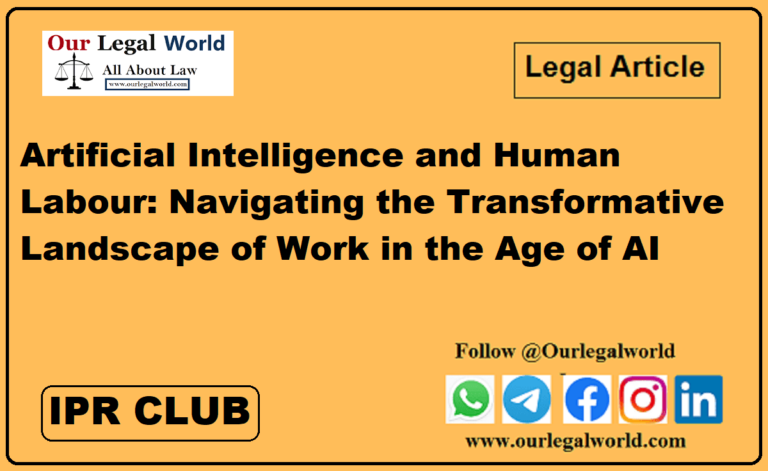Artificial Intelligence and Human Labour: Navigating the Transformative Landscape of Work in the Age of AI
- Arjun Bohare, Student in 4th-year Institute of Law Nirma University.
- Suryanshu Gupta, Student in 4th-year Institute of Law Nirma University.
Introduction
Explanation of AI
Artificial intelligence (AI) is a branch of computer science concerned with the development of algorithms and computer systems capable of performing tasks that normally require human intelligence, such as visual perception, speech recognition, decision-making, and language translation. Machine learning algorithms are used in AI systems to learn from data and improve their performance over time without the need for explicit programming. They can also use natural language processing and computer vision to understand and generate human language, as well as interpret and analyze visual data.
AI has numerous applications in fields such as healthcare, finance, transportation, education, and entertainment. AI-powered systems, for example, can aid in the diagnosis of diseases, the analysis of financial data, the control of autonomous vehicles, the personalization of education, and the recommendation of films or music based on individual preferences.
Also Read: The Renowned DABUS Case: Revisiting To Seek Imperative Legal Clarity
AI has advanced significantly in recent years as a result of advances in computing power, data storage, and machine learning algorithms. Deep learning, a subset of machine learning, has allowed AI systems to learn from massive amounts of data, resulting in advances in computer vision, natural language processing, and speech recognition.
AI has the potential to transform many aspects of our lives as it evolves, including the way we work, communicate, and interact with technology. However, as AI becomes more common, it raises significant ethical and societal concerns about its impact on human labour, privacy, and decision-making.
The Impact of AI on human labour
The impact of AI on human labour is a complex and multifaceted issue that has received a lot of attention in recent years. While AI has the potential to create new jobs and boost productivity, it also has the potential to automate and displace many existing jobs. Here are some of the ways artificial intelligence is influencing human labour:
Routine and repetitive task automation: Artificial intelligence systems can be used to automate routine and repetitive tasks like data entry, customer service, and manufacturing. This can result in increased efficiency and productivity, but it can also result in job losses for those who perform these tasks.
Increased productivity and new job opportunities: AI can help workers make better decisions by providing insights and recommendations. It may also lead to the creation of new job opportunities in fields such as data analysis, software development, and machine learning.
Workers may need to learn new skills as AI systems become more prevalent in order to remain competitive in the job market. Programming, data analysis, and machine learning are examples of such skills.
Changes in the nature of work: AI may cause changes in the nature of work, with workers spending more time on tasks that require creativity, critical thinking, and problem-solving abilities. This could lead to the creation of new jobs that require these skills.
Concerns about ethics: The use of AI in the workplace raises serious ethical issues, such as the possibility of bias in decision-making algorithms, the impact of automation on job security and income inequality, and the need to ensure that workers are not exploited by AI systems.
Overall, the impact of artificial intelligence on human labour is a complex issue that necessitates careful consideration of both the benefits and potential risks. While AI has the potential to increase productivity and create new job opportunities, it is critical to ensure that workers are not left behind as the technology evolves. This may necessitate investments in education and training programs to assist workers in acquiring the skills required to succeed in a world where AI is becoming more prevalent.
The impact of AI on the labor market
Explanation of how AI is affecting different industries and types of jobs
AI is having an impact on a variety of industries and job types. It improves medical diagnoses and treatment development in healthcare, but it may result in job displacement in administrative tasks. It is used in finance to analyze data for investment decisions and to automate fraud detection, but it may result in job displacement. AI-powered robots are being used in manufacturing for assembly and quality control, which may result in job displacement. AI-powered chatbots and virtual assistants are providing support and handling customer complaints in customer service, but this may result in job displacement. AI is being used in transportation to improve safety and efficiency, but it may result in job displacement for drivers and transportation workers. The impact of AI varies depending on the application, but it’s critical to consider the possibility of job displacement and invest in education and training programs to help workers learn new skills.
Discussion of potential benefits and drawbacks of these changes
The impact of AI on human labor has both potential benefits and drawbacks, which are important to consider.
Benefits:
- Increased efficiency and productivity: AI has the potential to automate time-consuming and repetitive tasks, resulting in increased efficiency and productivity. This allows human workers to concentrate on more creative and complex tasks that require critical thinking and problem-solving abilities.
- Improved accuracy and quality: AI-powered systems can analyze massive amounts of data quickly and accurately, potentially improving accuracy and quality in industries such as healthcare and finance. This can lead to improved patient outcomes and more efficient investment decisions.
- Cost savings: AI can assist in cost reduction by automating tasks, reducing errors, and improving efficiency. This can result in cost savings for both businesses and individuals.
Drawbacks:
- Job displacement: One of the most serious disadvantages of AI is the possibility of job displacement. As artificial intelligence (AI) becomes more prevalent in various industries, some workers’ jobs may be automated, resulting in unemployment and financial instability.
- Skills gap: As artificial intelligence (AI) becomes more prevalent, there is an increasing demand for workers with specialized skills and knowledge, such as data analysis and programming. However, many industries face a significant skills gap, which could lead to a shortage of qualified workers.
- Privacy concerns: AI-powered systems rely on massive amounts of data to function properly, raising privacy concerns. In healthcare, for example, AI systems may analyze patients’ medical records, raising privacy and security concerns.
- Bias: AI systems can reflect their creators’ biases as well as the data they are trained on, resulting in unfair or discriminatory outcomes. This has the potential to exacerbate existing inequalities in society and have unintended consequences.
To summarize, while AI has the potential to provide significant benefits such as increased efficiency, improved accuracy, and cost savings, it is critical to consider the potential drawbacks such as job displacement, skill gaps, privacy concerns, and bias. To maximize the benefits of AI while minimizing the risks, it is critical to invest in education and training programs to assist workers in acquiring new skills, developing ethical and transparent AI systems, and ensuring that the benefits of AI are shared fairly and equitably.
The ethics of AI and labour
Responsibilities of companies to workers whose jobs are being replaced by AI
As AI technology advances, there is growing concern about how AI will affect human labour. Companies must ensure that employees whose jobs are being replaced by AI are treated fairly and equitably. Companies should consider the following responsibilities:
- Provide training and support: Companies should provide workers whose jobs are being replaced by AI with training and support to help them learn new skills and transition to new roles. Access to education and training programs, job placement services, and financial assistance are all examples of this.
- Offer severance packages: Workers whose jobs are being eliminated by AI should be offered severance packages to help them through the transition period. These packages should be equitable and provide adequate financial assistance to help workers cope with job loss.
- Ensure a transparent and fair selection process: Companies must ensure that the hiring process for workers whose jobs will be replaced by AI is transparent and fair. This includes informing employees about the selection criteria and ensuring that the process is free of bias and discrimination.
- Engage in open and honest communication: Companies should communicate openly and honestly with workers whose jobs are being replaced by AI. This includes informing employees about the reasons for the job loss as well as the steps the company is taking to support them during the transition period.
- Consider alternative employment options: Companies should think about alternative employment opportunities for workers whose jobs are being replaced by AI. This can include creating new positions within the company or collaborating with other businesses to provide employment opportunities for affected workers.
To summarize, businesses must treat workers whose jobs are being replaced by AI fairly and equitably. This includes offering severance packages, providing training and support, ensuring a transparent and fair selection process, engaging in open and honest communication, and considering alternative employment options. Companies can help to mitigate the impact of AI on human labor and ensure a fair and equitable transition to a more automated future by taking these steps.
How AI can be designed and implemented in a way that maximizes benefits to workers and society as a whole
Designing and implementing AI in a way that maximizes benefits to workers and society requires careful consideration of ethical, social, and economic factors. Here are some key points to consider:
- Develop ethical and transparent AI systems: AI systems must be built with ethical considerations like fairness, accountability, and transparency in mind. This includes ensuring that AI systems are free of bias and discrimination, and that their decision- making processes are transparent and explainable.
- Prioritize the human element in AI design: Rather than replacing human workers, AI should be designed to supplement human skills and increase productivity. This necessitates a focus on human-centered design principles, which prioritise workers’ needs and experiences.
- Invest in upskilling and reskilling programs: As AI technology advances, many workers will be required to learn new skills and transition to new roles. Companies and governments must invest in upskilling and reskilling programs to ensure workers’ ability to adapt to changing roles and industries.
- Foster collaboration between industry, government, and academia: AI research and development should be a collaborative effort involving industry, government, and academia. This can help to ensure that artificial intelligence is developed and implemented in a way that benefits society as a whole.
- Establish regulations and standards: To ensure that AI is used safely and responsibly, regulations and standards for AI development and implementation must be established. Guidelines for data privacy, security, and ethical considerations are included.
The role of AI in job training and Upskilling
Opportunities for workers to learn new skills and take on new roles
Workers must adapt and learn new skills to stay competitive in the job market as AI technology advances and disrupts traditional industries. This shift, however, provides opportunities for workers to learn new skills and take on new roles. Here are some ways for workers to adapt and thrive in the AI era:
- Upskilling and reskilling programs: Many businesses and governments are investing in upskilling and reskilling programs to assist workers in gaining the skills required to transition to new roles and industries. These programs may include data analytics, coding, and project management training.
- Entrepreneurship and freelancing: Because of the rise of the gig economy and online marketplaces, workers now have more opportunities than ever to start their own businesses or work as freelancers. This can give you more flexibility and autonomy, as well as the chance to learn new skills and pursue new interests.
- Collaborative learning and mentoring: Workers can also gain new skills and knowledge by participating in collaborative learning and mentoring programs. These programs can provide a safe haven for employees to learn from one another and share their experiences.
- Emerging industries and job roles: AI is spawning entirely new industries and job roles, such as data scientists, AI ethicists, and robotics engineers. Workers can learn new skills and take on new challenges as a result of these emerging industries and roles.
Discussion of how AI can be used to provide job training and upskilling programs
AI can be used to provide job training and upskilling programs in a variety of ways, including:
- Personalized learning: Individual needs, preferences, and learning styles can be used to personalize learning experiences. This can boost the effectiveness and efficiency of training programs, as well as learners’ engagement and motivation.
- Adaptive learning: Based on learner performance and progress, AI can adapt learning experiences in real time. This can help to accelerate learning and improve retention by ensuring that learners are always working at an appropriate level.
- Predictive analytics: Predictive analytics can be used by AI to identify skill gaps and recommend training programs tailored to the needs of individual learners or groups of learners. This can help to ensure that training programs are centered on the skills and knowledge that are most in demand in the workplace.
- Gamification: To make learning more engaging and motivating, AI can incorporate gamification elements into training programs such as badges, leaderboards, and rewards. This can help to increase training program participation and completion rates.
- Virtual reality and simulation: AI can be used to create virtual reality and simulation training environments, allowing students to practice and apply new skills in a safe and controlled environment. This is especially useful for training in high-risk or complex environments like healthcare or manufacturing.
The future of work in an AI-powered world
What the job market might look like in 5, 10, or 20 years
Predicting the job market in the future can be challenging, but there are some trends that can provide insights into what it might look like in 5, 10, or 20 years.
- Increased demand for AI-related roles: As AI technology advances, there will be a greater demand for AI-related positions such as data scientists, AI ethicists, and robotics engineers.
- Automation of routine tasks: As more routine tasks are automated, demand for low- skilled jobs such as assembly line workers and data entry clerks may decline.
- Expansion of the gig economy: The gig economy, defined by freelance and contract work, is expected to expand further. This can provide workers with flexibility and autonomy, but it can also lead to a lack of job security and benefits.
- Emphasis on soft skills: As machines take over more routine tasks, an increased emphasis will be placed on soft skills such as communication, creativity, and problem- solving. These abilities will be in high demand because they cannot be easily replicated by machines.
- Increased demand for healthcare roles: As the population ages and medical technology advances, there will be a greater demand for healthcare professionals such as doctors, nurses, and home health aides.
- Sustainability and environmental jobs: There will be a greater emphasis on sustainability and environmental concerns, which will lead to an increase in jobs in renewable energy, sustainable agriculture, and conservation.
- The emergence of new industries: As technology advances, new industries that do not exist today may emerge. It is difficult to predict what these industries will be, but they may necessitate the acquisition of new skills and knowledge.
How AI will continue to shape the way we work
Artificial intelligence (AI) is rapidly changing the way we work, and its impact will only grow in the coming years. Here are some of the ways AI will continue to influence how we work:
- Automation: Artificial intelligence will continue to automate routine and repetitive tasks, freeing up humans to focus on higher-value tasks that require creativity and critical thinking.
- Decision Making: AI will help humans make better decisions by providing data-driven insights and predictions.
- Personalization: By analyzing massive amounts of data and tailoring services and products to individual needs, AI will enable personalized experiences for employees, customers, and clients.
- Collaboration: AI will enable teams to collaborate more effectively by automating routine communication and facilitating knowledge sharing.
- Skill Development: AI will allow for new forms of learning and development, allowing employees to learn new skills and knowledge at their own pace and in a personalized manner.
- Safety: AI will help ensure safer working conditions by monitoring and analyzing data to detect potential hazards and risks.
- Efficiency: AI will help organizations become more efficient by optimizing processes, reducing waste, and minimizing errors.
- Innovation: AI will facilitate innovation by generating new ideas and insights, identifying new opportunities, and enabling experimentation.
Overall, artificial intelligence (AI) is poised to play an increasingly important role in shaping the way we work, and organizations that embrace its potential are likely to reap significant benefits in terms of productivity, innovation, and competitiveness.
Conclusion
A. Final thoughts on the impact of AI on human labour.
The impact of AI on human labour is a complex and ongoing debate. While AI is expected to improve workplace productivity, efficiency, and innovation, it is also expected to have a significant impact on the labour market.
One of the main concerns is that AI will automate many jobs that are currently performed by humans, potentially leading to job displacement and high levels of unemployment. It is important to note, however, that while some jobs may be automated, new job types will be created, and existing jobs may be transformed.
Furthermore, AI is not a stand-alone solution; rather, it is a tool for augmenting human capabilities. In this sense, AI can boost human workers’ productivity and creativity, making them more effective in their roles.
It’s also critical to consider AI’s ethical implications and societal impact. As artificial intelligence becomes more sophisticated and integrated into our lives, it raises concerns about privacy, bias, and social inequality. It is critical to ensure that artificial intelligence is developed and used responsibly and ethically, with appropriate regulations and oversight in place.
To summarize, while the impact of AI on human labour is complex and multifaceted, it is clear that AI will continue to play a growing role in the workplace. It is up to us as a society to ensure that the benefits of AI are maximized while the risks are minimized.
BIBLIOGRAPHY
- Autor, D. (2015). Why are there still so many jobs? The history and future of workplace automation. Journal of Economic Perspectives, 29(3), 3-30.
- Brynjolfsson, E., & McAfee, A. (2014). The second machine age: Work, progress, and Prosperity in a time of brilliant technologies. W. W. Norton & Company.
- Frey, C. B., & Osborne, M. A. (2017). The future of employment: How susceptible are jobs to computerisation? Technological Forecasting and Social Change, 114, 254-
280. - World Economic Forum. (2018). The Future of jobs report 2018.
- Arntz, M., Gregory, T., & Zierahn, U. (2016). The risk of automation for jobs in OECD countries: A comparative analysis. OECD Social, Employment and Migration Working Papers, (189), 1-33.
- Manyika, J., Chui, M., Miremadi, M., Bughin, J., George, K., Willmott, P., Dewhurst, M., & Saleh, T. (2017). Jobs lost, jobs gained: What the future of work will mean for jobs, skills, and wages. McKinsey Global Institute.






